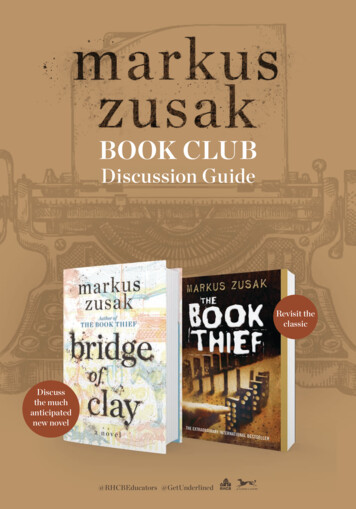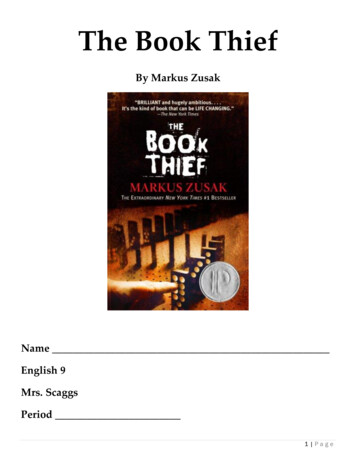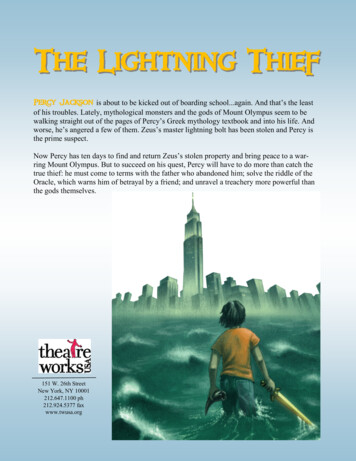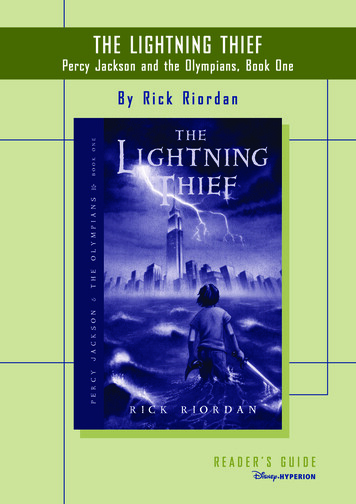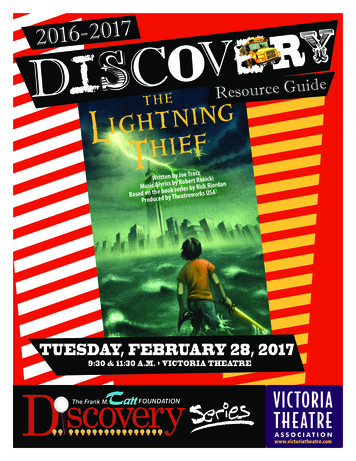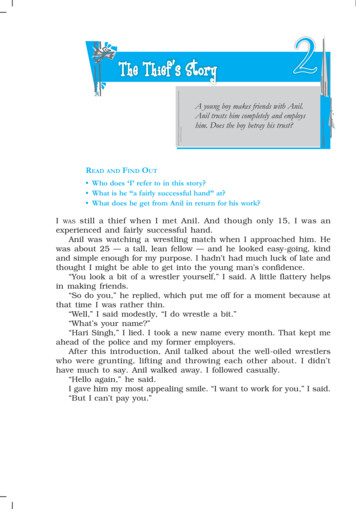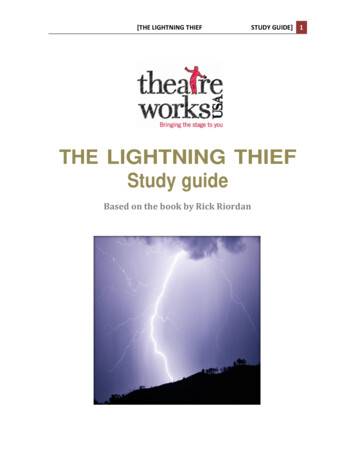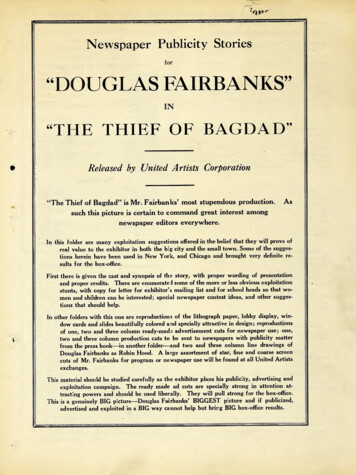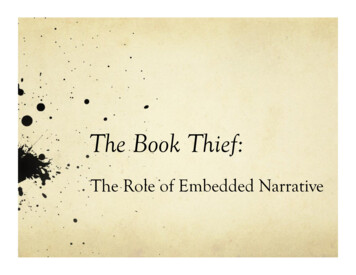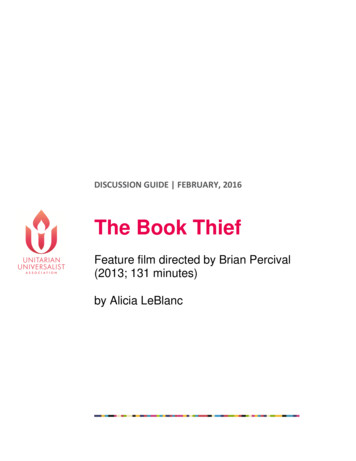
Transcription
DISCUSSION GUIDE FEBRUARY, 2016The Book ThiefFeature film directed by Brian Percival(2013; 131 minutes)by Alicia LeBlanc
Table of ContentsIntroduction . 3Session 1: Symbols . 4Session 2: Storytelling . 7Session 3: Justice in the World . 9Leader Resources. 12Leader Resource 1, Game Questions, "Easy"Leader Resource 2, Game Questions, HarderLeader Resource 3, Game Questions, DifficultLeader Resource 4, Game AnswersUnitarian Universalist Association / Faith Development Office2
IntroductionThe Book Thief (2013, 131 minutes), directed by Brian Percival, is based on the novel of the samename by Markus Zusak. The Book Thief takes place during World War II in Germany and tells thestory of Liesel Meminger, a German girl, who faces the reality of war after her family harbors aJewish person named Max Vandenburg. While World War II is an important historical topic, thefocus of this discussion guide is on connections between symbols, words, and justice and howthese topics influence one’s life.This discussion guide focuses on the film and is appropriate for a high school discussion group,but can be adapted for various ages. Each session is 60 minutes in length (not including filmviewing time). Facilitators are invited to participate in the discussion; all ideas are welcome andconsidered learning experiences for everyone in the group. The location of the meetings can beanywhere—a religious education classroom, an after-school program, or a book club. If yourprogram has time for it, you might have the group watch the film together. Familiarity with TheBook Thief novel is not necessary; however, comparing and contrasting the film with the book mayoffer a more enriching experience. Additional film and book suggestions are at the end of thisguide in the Find Out More section on page 11.About the AuthorAlicia LeBlanc is the Administrative and Editorial Assistant for the Unitarian UniversalistAssociation’s Faith Development Office in the Ministries and Faith Development staff group. Sheearned her B.A. in English from Merrimack College in North Andover, MA. In 2014, she receivedher M.A. in English Literature from the University of Massachusetts, Boston. Alicia is the webdesigner of the Religion in Life for Girl Scouts website and editor of the pamphlet To the Point. Inher spare time, Alicia enjoys reading fiction, studying graphic novels, and riding horses.Unitarian Universalist Association / Faith Development Office3
Session 1: Symbols (60 minutes)GoalsParticipants will: Play a game to help them recall events from the film and begin a deeper conversationDiscuss the definition of symbol in both historical and contemporary times as it applies toThe Book ThiefExplore how symbols are used in their daily lives as powerful tools that foster ideasRecognize that symbols can represent a reality; they can be instruments of both good andevil in the world.Materials Newsprint, markers, tape, crayons, and color pencilsChalice (or LED/battery-operated candle)Construction paper in different colorsScissors, including left-handed scissorsMagazinesTableLeader Resource 1, Game QuestionsLeader Resource 2, Game AnswersA small hourglass or timepiece device (10 seconds)Lined paper and pens or pencilsA coinPreparation Cut out Leader Resource 1, Game Questions. Thought bubbles with a non-bold outlinehave a 5-point value. Bold-outlined thought bubbles are worth 10 points and zigzags, 15.Review Leader Resource 2, Game Answers, before playing the game.Place construction paper, drawing implements, tape, scissors, and magazines on a table.Opening (2 minutes)Welcome participants to the meeting space. Invite a volunteer to light the chalice as you or avolunteer read aloud the opening words, “The Chalice Is a Symbol,” by Debra Faulk, from theUUA’s Worship Web:A chalice lit in our midst is a symbol of our liberal faith,A faith built on the foundation of freedom, reason and toleranceA faith sustained by acts of kindness and justiceUnitarian Universalist Association / Faith Development Office4
A faith that visions a world flourishing, with equality for all her peopleA faith that demands the living out of goodnessA faith that requires thoughtfulnessA faith of wholenessThis tiny flame is the symbol of the spark of all this within each of us.Activity 1: Let’s Play a Game (20 minutes)Form two teams. (If the group is small, conduct the activity as a whole group.) Say in these words,or your own:We are going to play a game as a way to review The Book Thief. Teams will take turnsanswering questions that will test your memory of the movie. A coin will be tossed todetermine which team picks the first question. Each group picks from three categories:easy, medium, and difficult. Team A will have as long as the hourglass timer (or stopwatch) to answer the question. If they do not answer correctly, Team B will have a chanceto respond. If Team A answers correctly, then it is Team B’s turn to answer a question.The game continues until all questions have been answered. Easy questions are worthfive points, medium are worth ten, and difficult are worth fifteen.If prepared questions run out and there is still time, invite the teams to write their own questions onlined paper and quiz each other. The facilitator will keep track of the scores. The team with themost points wins. Perhaps the winners can pick the next movie or book for the group to discuss, ifthe group has an ongoing commitment to meet.After the game, ask: Which scenes from the movie did you remember best? Why do you think this is so? Did you remember any more symbols while playing the game?Activity 2: Discussion (15 minutes)Share a definition of symbol with the group. From The American Heritage New Dictionary ofCultural Literacy, a symbol is defined assomething that represents or suggests something else. Symbols often take the form ofwords, visual images, or gestures that are used to convey ideas and beliefs. All humancultures use symbols to express the underlying structures of their social systems, torepresent ideal cultural characteristics, such as beauty, and to ensure that the culture ispassed onto new generations.Prompt discussion with preliminary questions such as: What have you learned about World War II in school and other places?Unitarian Universalist Association / Faith Development Office5
What are some of symbols in The Book Thief? What type of responses do they elicit inpeople? How do you think the Hubermann family felt seeing the swastika hanging fromtheir door and their neighbors’ doors? Have you ever encountered a symbol or image that represents hate? Or a symbol thatrepresents something good? How did you react in either situation? What was the purpose of the book burning? How did you feel when the youth weresinging? What could be ramifications of Liesel stealing a book from the smoldering fire? Does your family have a cultural or ethnic symbol that also represents your identity?Activity 3: Make a Symbol (20 minutes)Symbols are prevalent in The Book Thief and are used to achieve various ends. This activityexplores symbols in participants’ lives and in the film. Explain, in these words or your own:Pick a sheet of construction paper and choose additional materials from the table. Draw orcut out a symbol that represents your culture, your country, or a value you hold.Magazines are provided for you to browse through; you can create a real or imaginedsymbol with magazine pictures if you choose.When they have finished, ask if anyone would like to briefly share their symbols. Using thedefinition of symbol shared earlier, ask if their symbols “convey ideas and beliefs” they hold. Doestheir symbol represent something physical about themselves? Something abstract?Closing (3 minutes)Ask participants to return the crafts to the table. If there is energy for continuing the conversation,explain that questions not covered in Session 1 can be discussed in Session 2. Conclude thesession with the following brief meditation, explaining that this meditation is inspired from the book;the opening pages explain that Death sees people as shades of color:Close your eyes if you feel comfortable doing so. Take a few deep breaths. Imagine yourfavorite color. What does your favorite color represent for you? Picture it in your mind andbreathe deeply. Embrace the feeling the color brings to you. I leave you with this feelingtoday.[Pause for a moment] Open your eyes. Thank you for participating in this session.Extinguish the chalice.Unitarian Universalist Association / Faith Development Office6
Session 2: Storytelling (60 minutes)GoalsParticipants will: Discover that storytelling is a powerful mode of communication in times of joy or struggleExplore how and why Liesel uses stories in The Book ThiefWrite of a time when they used storytelling or words to comfort, support, or encouragesomeone in their life.Materials Chalice (or LED/battery-operated candle)Lined paper and pens or pencilsPreparation If your meeting takes place in a space that is suitable for small group discussion, createareas for small groups to gather around tables.Place paper and writing implements on tables.Opening (2 minutes)Welcome participants to the meeting space. Invite a volunteer to light the chalice as the openingwords by Ean Huntington Behr, from the UUA’s Worship Web, are read aloud:You are in the story of the world.You are the world coming to know itself.May you trust that all you will ever say or doBelongs in the story of the world.Activity 1: Discussion (20 minutes)The Book Thief delves into Liesel’s relationship with books, words, and storytelling. Promptdiscussion with the following questions: How does Liesel use her knowledge of words and reading? Why do you think words orbooks are powerful? How are her words used: for good? For bad? Why does Liesel steal books? At some point in most of our lives, caregivers have told usthat stealing is wrong. Yet, in Liesel’s situation, she steals for learning and, in doing so,Unitarian Universalist Association / Faith Development Office7
helps people through her gift of storytelling. Under what circumstances might stealing beokay? Have you ever been in a situation where you questioned what was right or wrong?What was the outcome?Activity 2: The Power of Storytelling (35 minutes)Describe the activity in these words or your own:For the next 20 minutes, you will write about stories and storytelling. Have you ever had tocreate a story (for a friend, sibling, relative, a stranger)? What was the process like foryou—difficult, easy, somewhere in-between?Think about words and how they can affect thoughts and actions. How are words used inpoems? Songs? Books?Write about a time the act of storytelling made an impact on your life: Have words orstories ever comforted you, challenged you in some way, or changed your life? You maydraw an illustration to complement your story.When you have 15 minutes left in this activity, invite participants to stop and share their writing. Ifthis is not enough time to allow the entire group to share together, form smaller groups for sharing.Say:Storytelling, writing, and books are such an integral component of The Book Thief. That iswhy we are going to spend these last 15 minutes reading our writing aloud. You may“pass” if you do not wish to share.Closing (3 minutes)If there is energy for continuing the conversation, explain that questions not covered in Session 2can be discussed in Session 3. Conclude the session with the following words:Describe the day If your eyes could speak, what would they say? — Max Vandenburg,from the movie The Book ThiefExtinguish the chalice.Unitarian Universalist Association / Faith Development Office8
Session 3: Justice in the World (60minutes)GoalsParticipants will: Discuss themes of justice and injustice in The Book ThiefExplore social justice within their communities to connect the justice theme of the book tothe present dayDiscuss how to continue the larger conversation about symbols, storytelling, and justicewith family members, friends, and people in their communitiesReflect on moral lessons learned and other take-aways from viewing The Book Thief.Materials Chalice (or LED/battery-operated candle)Writing paper, pens, and pencilsElectronic devices with an Internet connection, such as tablets, cell phones, or computers,one for every three participantsNewsprint, markers, and tapePreparation Place writing paper, pens, and pencils on tables.On a sheet of newsprint, write the links to resources provided in the Find Out More section,below. You can also create a document for participants to take home, or, make plans toemail or text participants the links after the session.Opening (2 minutes)Welcome participants to the meeting space. Invite a volunteer to light the chalice as you or avolunteer read the opening words, from The Book Thief, aloud:In my job, I’m always finding humans at their best and their worst. I see their ugliness andtheir beauty, and I wonder how the same thing can be both. — Death (narrator)Activity 1: Discussion (25 minutes)Focus this final discussion on the theme of justice in the film. Distribute paper and pens or pencils.Participants can write notes and thoughts about the questions if they choose. Prompt with thefollowing questions:Unitarian Universalist Association / Faith Development Office9
Liesel’s actions supportive of justice? What type(s) of justice does she exhibit? What injustices, if any, take place in your community? Do people turn away from injustice?If you see injustices being ignored, why do you think this occurs? Have you been pulledinto an injustice unwillingly? How have you worked to combat the effects of injustice in your community? Or in thewider world? Is the narrator, Death, a form of justice? Could the way people died at the end of the filmbe a type of justice? Why or why not?Activity 2: Continuing the Conversation (30 minutes)Take about 25 minutes to discuss ways participants can extend their responses to The Book Thief.Prompt with the following questions: Do you plan to bring the conversations from these discussions about World War II or theHolocaust to your family? To your friends? Is there one lesson or moral you have taken away from our discussions about The BookThief? Would you be willing to share it, now, with the group? If you have read the book, how are the two art forms, film and book, different or similar?Why do you think the film is different from the book? What are some next steps you could take to further compassion and justice in yourcommunities? What local social justice networks could you volunteer with, such as ashelter, a food bank, or a group planning a justice rally for a cause you are passionateabout?Spend at least five minutes using the Internet to research social justice networks in your area.Form groups of three and ask participants to locate two or three opportunities to pursue followingthis discussion series. Invite them to share their results with the larger group.An alternative is to invite participants to explore the physical space of the congregation, includingposted newsletters, social justice pamphlets, etc., to discover justice projects already embraced bythe congregation. Make plans to participate in these projects in age-appropriate ways. Consult amember of the justice committee or the congregation’s religious educator if more ideas are needed.Closing (3 minutes)Thank everyone for their participation in the discussion. If participants show some energy forcontinuing the conversation, explain that questions can be discussed through email or at futureUnitarian Universalist Association / Faith Development Office10
group meetings. Share the Find Out More links with participants. Conclude the session with thefollowing reading from the UUA’s Worship Web:We have come into this room of hopewhere our hearts and minds are opened to the future.We have come into this room of justicewhere we set aside our fear to name freely every oppression.We have come into this room of lovewhere we know that no lives are insignificant. — Libbie D. StoddardExtinguish the chalice.Find Out More The Book Thief by Markus Zusak (New York: Alfred K. Knopf, 2005) Fahrenheit 451 by Ray Bradbury (New York: Ballantine Books, 1979) explores themeaning of books in a world where book burning is a regular occurrence. There is also amovie of the same name. “Unitarian Couple Honored for World War II Heroism,” by Michelle Bates Deakin (UUWorld, Dec. 12, 2005), is a story about Martha and Waitstill Sharp, who fostered justice inwar-torn Europe by rescuing refugees; nored-world-war-ii-heroism. Anne Frank used words in much the same way as Liesel and took comfort in them whilehiding from the Nazis. A website about Anne Frank features information about her life,story, and diary; www.annefrank.org. The United States Holocaust Memorial Museum provides more information aboutKristallnacht and the Hitler Youth; www.ushmm.org.Unitarian Universalist Association / Faith Development Office11
Leader ResourcesThe Session 1 game uses all four Leader Resources. Leader Resource 1: Game Questions – “Easy” (5 points) Leader Resource 2: Game Questions – Harder (10 points) Leader Resource 3: Game Questions – Difficult (15 points) Leader Resource 4: Game AnswersPrint each Leader Resource on a separate, single-sided sheet of paper. If possible, print in color.Cut apart the questions on Leader Resources 1, 2, and 3. Plan to put them into three separatecontainers (“easy,” harder, and difficult) or all together in a single container—depending on howyou wish to play the game.Keep Leader Resource 4: Game Answers out of participants’ sight!Unitarian Universalist Association / Faith Development Office12
Leader Resource 1: Game Questions, “Easy” (5 points)Unitarian Universalist Association / Faith Development Office13
Leader Resource 2: Game Questions, Harder (10 points)Unitarian Universalist Association / Faith Development Office14
Leader Resource 3: Game Questions, Difficult (15 points)Unitarian Universalist Association / Faith Development Office15
Leader Resource 4: Game Answers“Easy” – 5 points1. Heaven’s Street2. Accordion3. A gravedigger’s book or The Grave Digger’s Handbook4. Into the river5. A journal6. Humans7. Under a Nazi flag8. Laundry serviceHarder (bold outline) – 10 points9. Werner10. Your Majesty11. Her brother12. Two years13. Ninety years14. Borrowing15. Three Xs or XXX16. A snowmanDifficult (zigzag) – 15 points17. The accordion18. In the basement at her writing desk19. Soccer (or football, or running)20. Hitler’s birthday21. Hitler Youth22. Looks up to the sky, or looks at the night skyUnitarian Universalist Association / Faith Development Office16
name by Markus Zusak. The Book Thief takes place during World War II in Germany and tells the story of Liesel Meminger, a German girl, who faces the reality of war after her family harbors a Jewish person named Max Vandenburg.
